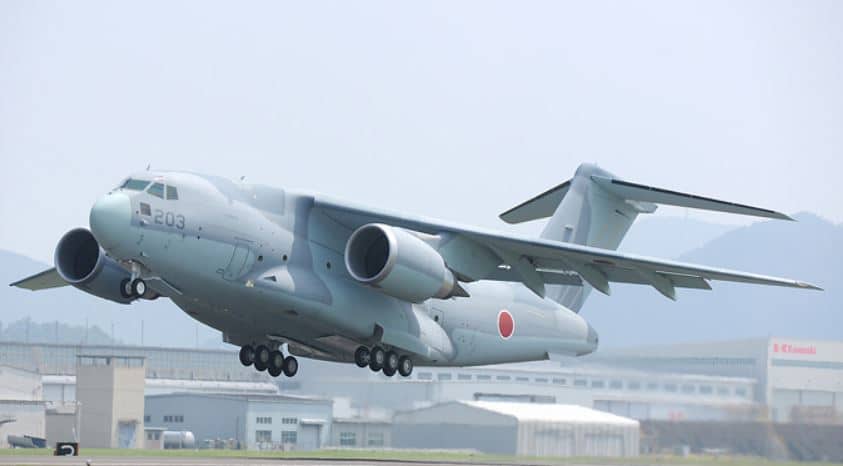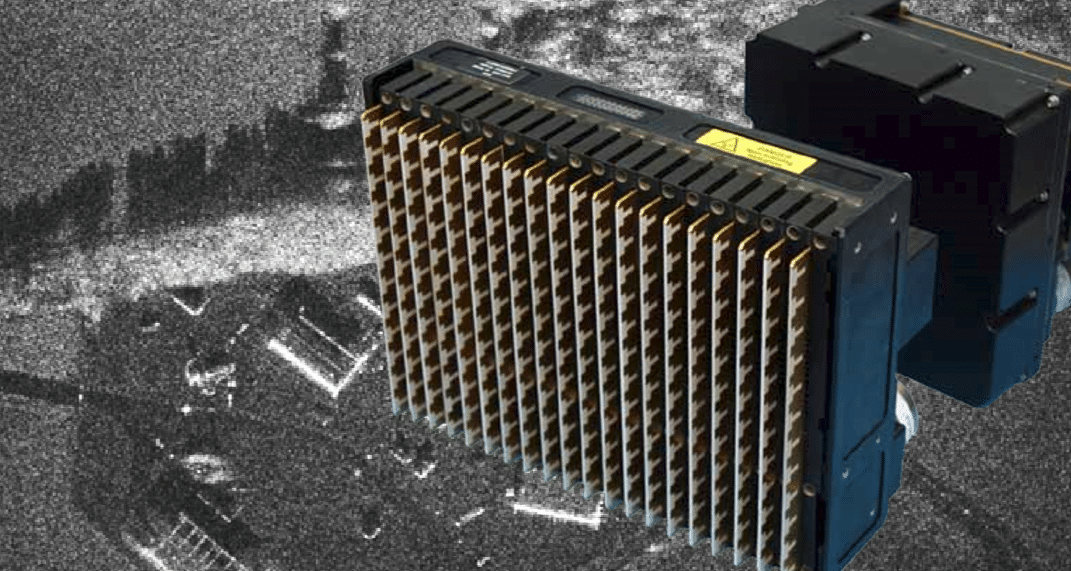2530Views 23Comments

Kawasaki Heavy Industries to market C-2 transport to the Middle East
Japan’s Kawasaki Heavy Industries will begin marketing its C-2 heavy transport aircraft to Middle Eastern markets, such as the United Arab Emirates (UAE). The effort is part of the Japanese Ministry of Defence’s (MoD) objective of entering the global defence industry market, particularly with the Kawasaki C-2 and P-1 maritime patrol aircraft (MPA). The P-1 MPA made its international debut at the 2017 Paris Air Show.
The Nikkei Asian Review reported that the Japanese government was already in the process of engaging with the UAE over the possible sale of C-2 aircraft. The UAE is reportedly interested in the C-2. Kawasaki Heavy Industries will present the C-2 at the forthcoming Dubai Air Show in November.
Kawasaki Heavy Industries is pitching the C-2 as a heavyweight complement to the C-130 Hercules (and in the absence of the discontinued Boeing C-17). As per IHS Jane’s, the C-2 has a payload of 30 tons and can fly a range of up to 5,600 km. According to the Nikkei Asian Review, it has a unit price of $173 million U.S.
The C-2 is powered by two General Electric (GE) CF6 turbofan engines, an ubiquitous design that powers a wide range of civilian airliners, among them the Boeing 747 and Airbus A330.
Comparable strategic airlifters include the propfan-powered Airbus Defence & Space (DS) A400M and Antonov (under UkroBoronProm) An-70. Russia’s VTA IL-76MD-90A is a jet-powered alternative.
The Airbus DS A400M has a payload of 30 tons, with which it can fly a range of 4,500 km (and 6,400 km with a 20-ton payload). With a 35-ton payload, the An-70 can fly 5,100 km, but the platform is not in production. UkroBoronProm is hoping to revive the An-70 with U.S. industry support under the Antonov An-77 program. The IL-76MD-90A can reach 5,000 km with a 52-ton payload.



23 Comments
by Jigsaw
Guess the Japs are leaving Chinese behind in copying American designs…This one looks like a serious rip off of the C-17 globemaster.
by U
LoL, at first sight I thought it was a licensed copy 😂
by ahmria
I very much doubt that Japan needs to copy American designs like the C17. The two aircraft look similar because the designers of both aircraft probably came to the same or similar design solutions for requirements when designing both jets.
by Aamir
The C-2 is derived from its predecessor the C-1, in appearance both aircraft are very similar. The C-1 has been in operational use since 1974, development started in the mid to late 60’s.
by Joseph
You should have a look of Japanese F-2. I’d say that both planes are more than coincidence.
by Joe Honick
Overlooked in all these PR releases is the reality of how the Saudis have worked hard and well to knit together deals with the Russians and the Chinese, efforts that were highlighted, but begun earlier, last year as the Saudi king, leading a small army of 1500 deal makers, moved through Asia. Then just recently the Chinese put together their own deal with Russia to make passenger aircraft. So the discussion is not just about the technical stuff but as much that other nations have found how to make alliances that seem to zoom right past the chaos in Washington.
by Jigsaw
I know some people don’t agree but a closer look at in-service transport aircraft reveals strong resemblance between C-2 and C-17. I also read somewhere that Japanese acknowledge the striking similarities between C-2 and C-17 to be more than a coincidence. Then of course there is the F-2. It’s not a biggie because US itself seems to have allowed and helped JSDF develop from some of its own military platforms.
by Frkh
F2 is a collaboration between LM and Mitsubishi and based in F16.
by Aamir
As Joseph stated the F 2 is a result of collaboration between Lockheed Martin (LM) & Mitsubishi. The F2 is based on the F16.
by Jigsaw
And perhaps C2 is too.
by ahmria
The F2 was the result of collaboration between Lockheed and Mitsubishi. The actual aircraft is bigger than an F16 with larger wings and tail plane. It was also the first fighter jet to have an AESA radar installed.
by Joseph
I am mot trying to diminish Japan’s achievements, but when Japan had almost no experience in making jets like F-2 and C1 & C2, it would be quite surprising, even foolish if Japan did not try to copy existing American designs.
Just like Americans copy Sea Harrier, Chinese copying Russian designs in the past. Chinese and Russian stealth fighters all somewhat look like F-22.
Re-inventing wheels is unnecessary and foolish, but we should at least not pretend we all somewhat come up with the idea of wheels independently.
by Jigsaw
To any avid observer its pretty obvious the similarities between the two planes. A lot of people on defence forums have noticed this. Unfortunately I am not able to find concrete citable sources for this thus far, except opinions and personal analysis, since the cooperation may have been carried out informally but it doesn’t change the similarities. C-2 also obviously uses considerable American tech.
by TZK
Japan, SKorea and perhaps Taiwan have developed a solid industrial base and have the infrastructure and technological capability to manufacture anything they wanted. They have relied on US hardware but increasingly are looking at producing as much as they can themselves. SKorean (KAI KF-X) and Japanese (X-2) are 5th gen fighters under development. The Kawasaki P1 is a competitor to USA P8 Poseidon.
by Jigsaw
“have the infrastructure and technological capability to manufacture anything they wanted” ?
Anything…Hmmm…interesting statement. Now research the programmes you mentioned to know how much capability these countries actually have to develop anything on their own.
by TZK
Better still Jigsaw google the equipment used by SKorean and Japanese armed forces and see for yourself that majority of it is indigenously produced. They may use US aircraft but I suspect that was a political decision rather than lack of capability to make their own.
by Aamir
It isn’t, here are two Wikipedia pages for both the C 2 & the F 2. The Japanese tested the C 17, C 130J & the A400. & felt that these aircraft did not fulfill the requirements of the JASDF & went on to develop the C 2. Both the C2 & C17 may look similar but they are different platforms.
https://en.m.wikipedia.org/wiki/Kawasaki_C-2
https://en.m.wikipedia.org/wiki/Mitsubishi_F-2
by Joseph
“have the infrastructure and technological capability to manufacture anything they wanted.”
If that is true then those jets would not be flying with American engines.
by Joseph
South Korea has been trying to develop their own 5th generation fighter, but heavily depending on US technology transfer: http://nationalinterest.org/blog/the-buzz/will-america-help-south-korea-build-lethal-stealth-fighters-14078
After reading that, can you say it again with a straight face that South Korea “have the infrastructure and technological capability to manufacture anything they wanted.”?
by TZK
US aerospace technology is probably the best and that is why the SKoreans want it. It boils down to reinventing the wheel or getting the technology off the shelf. My point being if the Koreans were forced to develop this technology they could do it but they have better things to do like making money from the US consumer by selling cars and electricals to them. Japan is building its own engine for its 5th gen jet.
by TZK
US aerospace technology is probably the best and that is why the SKoreans want it. It boils down to reinventing the wheel or getting the technology off the shelf. My point being if the Koreans were forced to develop this technology they could do it but they have better things to do like making money from the US consumer by selling cars and electricals to them. Japan is building its own engine for its 5th gen jet.
by Joseph
The truth is South Korea is too small a country in term of economy to develop full spectrum of technologies required for 5th generation fighter. It is only viable for US, Europe as a whole and China, maybe Japan. Even Russia is having difficulties, it’s military export is funding developments. If Su-57 is any indication Russia is already have troubles developing large scale new projects without partnering up with other nations. After all Russia’s economy is about the same size as South Korea.
It is possible for Japan to be able to afford such development, it’s economy is large enough, but the huge government debt is it’s Achilles’ heel. I think that is why Japan is partnering up with UK for it’s indigenous 5th generation fighter development.
Japan’s XF9-1 engine development is still in very early stage, it won’t be ready for at least 15 years. But it shows Japan is carrying very large part of the 5th generation fighter development project. After all it’s GDP is almost twice of UK.
by TZK
The SKorean KAI T-50 Golden Eagle uses the General Electric F404 (built under license by Samsung Techwin) afterburning turbofan according to Wiki. Size of economy is important but some nations with the technology have been perfecting engines since WW2 and have thousands of associated components manufacturers. Building something from scratch with thousands of moving parts all working to high temperature and pressure is a massive undertaking. USA, a military industrial complex since 1945, has a large part of their economy dedicated for this purpose.